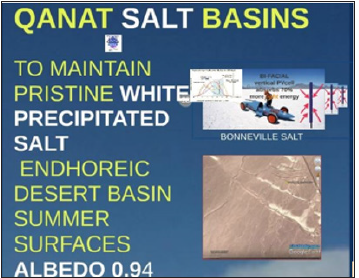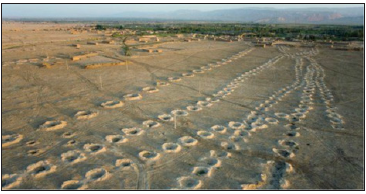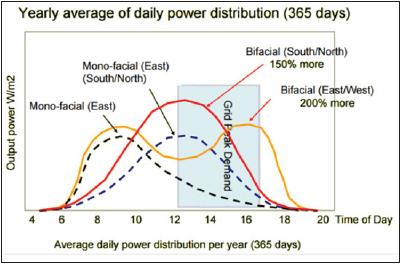- Submissions

Full Text
Novel Research in Sciences
Highly Efficient Bifacial PV Cylindrical Modules Positioned Over Areas of Massive Leached Pristine White Salt Crust Canopies, Designed to Additionally Enable Incremental Anthropogenic Control of World Albedo Absorption of Light Energy
David Bloch*
MR Bloch Salt Archive, Israel
*Corresponding author:David Bloch, MR Bloch Salt Archive, Israel
Submission: February 01, 2021;Published: March 09, 2021
.jpg)
Volume6 Issue3March, 2021
Abstract
The 3500-year-old Qanat, Karez, Aflāj, watershed tunnels and sweet water systems are the initial foundations of almost every ancient city community in Central Asia. They allowed controlled irrigation of fields of saline endorheic arid zone basins to regulate the production of Commonsalt crust for the earliest known civilizations. Without this highly engineered architecture often compared to the Great Wall of China or the Pyramids, these arid deserts would have remained desolate. The technique of forming white precipitated salt crust layers, provided a single economic resource enabling these ancient oasis communities to become the icons of historians and archaeologists. These vast desert areas may easily and cheaply be used again to form a white canopy of salt to provide an almost identical reflective or absorptive irradiation as is the case of the white snowed polar regions. With modern tools this ancient technology can be employed to incrementally move the mean global Albedo both positively or negatively, in the event of either a solar minimum or a solar maximum. By industrially creating a pristine white canopy of salt precipitate it would be possible to reflect more energy and increase or decrease the albedo index. Ancient Sabkha salt technology with the use of the Qanat Karez irrigation system, has in the past produced such a white canopy in vast expanses of existing uninhabitable endorheic basins. Existing natural white salar plateaux such as Bonneville, Kalahari and many others also could be cheaply brought under similar control. The archeology of the ancient Silk Road is a critical contribution to its reincarnation, as the new China Belt Road. Cylindrical bifacial PV panels are now an extremely valid application relevant to the proposed salt canopy systems. Since the efficiency of an almost shadow-less panel with solar tracking is optimal to the crystal white salt albedo, the infrastructure of such a system in the vacant endorheic basins positioned in equatorial latitudes, could not be more relevant, in that performance increases strongly depending on three factors: (i) the latitude, (ii) the local diffuse fraction and (iii) the albedo. We propose the use of stroboscope flat propeller shaped PV panels which revolve at 60 cycles per second to provide optimal reflected light [1-6].
Keywords: Bifacial cylindrical PV tracking modules; Albedo; Climate; Money; Irrigation; Common salt; Silk road qanat Aflāj Karez
Introduction
More than 150,000 Qanat Karez sweet water distribution systems, including more than 200,000 kilometers of tunnels are still to be found in almost all of the desert communities of Central Asia. Without the Qanat systems the communities could not have come into existence. The original objective of the Qanat Karez was to supply water to the arid Sabkha basins where salt deposits were leached as a result of dissolution, evaporation and re-crystallization (Figures 1-3). In Arabic, Sabkha means: “A flat coastal lagoon with a topsoil salt crust” also known as Salar. The surface and sub-soil of many Central Asian inland desert Sabkha basins may also be made up of diapirs of flat salt mirror geology. During the seasonally hot periods of the evaporation stage of the Qanat controlled ‘surge system, ‘ salts dissolve rapidly driving the process of re- crystallizing and precipitation of purer salts and more concentrated layered playa cakes, including microbial mat. The Qanat mountain watershed systems were engineered to regulate the shallow surge flooding of these endorheic basins without destroying the salt mirror playa and without causing erosion. By the end of the century 700 CE, the Islamic Shiia Jafari had completely reorganized the oasis management of most of the Qanat systems in the Central Asian deserts. As a result, they then controlled a major part of the civilisation’s salt production, together with its technology, along the Middle Eastern section of the Silk Road, and were then supplying most of Europe and the Mediterranean basin with salt. The Qanat Karez sweet water mechanism was invented some 3500 years ago. To the casual observer it is a very ancient, sophisticated feat of underground engineering which could be compared to the Egyptian Pyramids and the Great Wall of China. A more technical observer will see it not only as a means of transporting water for local domestic and agricultural use in the adjacent oasis settlements, but also as a means of supplying water beyond, to the very arid areas and the desert flat basins. The long lines of bore holes dotted along the desert floor basin were an integral part of the settlement [6-10] (Figures 4-7).
Figure 1:Bifacial tracking mounted cylindrical PV module with minimum profile.

Figure 2.

Figure 3.

Figure 4.

Figure 5:Schematic formation of endorheic basin Sabkha [Salar] crusts of salts and microbial mat.

Figure 6:Forming salt crust slabs showing clear microbial layers.

Figure 7.

References
- Bloch MR. Zur entwicklung der vom salz abhangigen 8 technologien. List Ges Basel p. 289.
- Bloch (1965) A hypothesis for the change of ocean levels depending on the albedo of the polar ice caps. Palaeogeography Palaeoclimatology Palaeoecology 1: 127-142.
- Bloch (2009)Heavy saline streams in salt driven wetlands, abandoned evaporation pans, domes and other salt deposits as the responsible hydraulic mechanisms causing the disappearance of heavy waste liquids, and other waste toxic sediments on land and in the ocean. CEISSA, Mexico.
- Bloch (1944) Occasional whiteness of the dead sea. Nature 154: 402-403.
- Bloch (1972) Geochemistry of ocean water bubble spray. JGR 77(27): 5100-5105.
- Bloch (1963) The social influence of salt. Scientific American 209(1): 88-98.
- Bloch (1964) Dust induced albedo changes of polar ice sheets and glacierization. Journal of Glaciology 5(38): 241-244.
- Bloch D (2018) The most perfect ecosystem: the qanat karez salt leaching oasis of the ancient silk road, as the model of aquaculture and chemical engineering to transform our present-day agriculture and climate temperature. Open access journal of environmental and soil sciences.
- David Bloch (1968) Revealing the original purpose engineered qanat-karez-falaj salt leaching system compared to the sabkha salt leaching and recovery today bloch salt archive.
© 2021 David Bloch. This is an open access article distributed under the terms of the Creative Commons Attribution License , which permits unrestricted use, distribution, and build upon your work non-commercially.
 a Creative Commons Attribution 4.0 International License. Based on a work at www.crimsonpublishers.com.
Best viewed in
a Creative Commons Attribution 4.0 International License. Based on a work at www.crimsonpublishers.com.
Best viewed in 







.jpg)






























 Editorial Board Registrations
Editorial Board Registrations Submit your Article
Submit your Article Refer a Friend
Refer a Friend Advertise With Us
Advertise With Us
.jpg)






.jpg)














.bmp)
.jpg)
.png)
.jpg)










.jpg)






.png)

.png)



.png)






